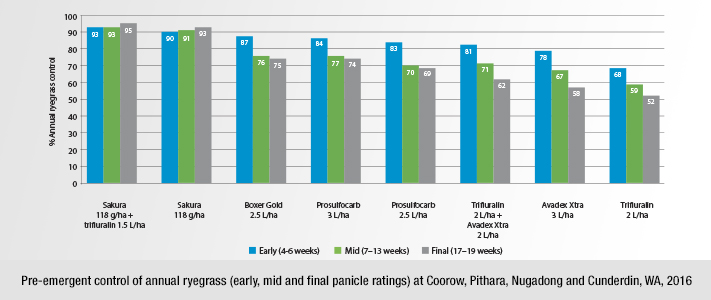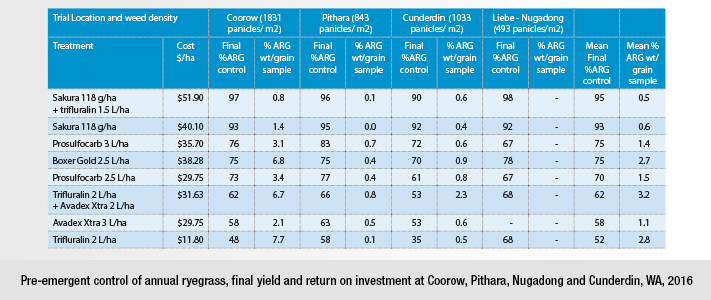Pre-emergent Trials Highlight Strength of Sakura
About
-
Category
- Grower Stories
- Product News
-
Date
15 February, 2017
-
Location
Coorow, Pithara, Nugadong and Cunderdin, WA
About
Category
- Grower Stories
- Product News
Date
15 February, 2017
Location
Coorow, Pithara, Nugadong and Cunderdin, WA

The trials were conducted in wheat at Coorow, Pithara, Nugadong and Cunderdin, all of which had good soil moisture at depth and, with the opportunity for a double knockdown of pre-sowing weeds, presented largely ideal conditions for pre-emergent herbicide applications at the start of the season.
In addition to prosulfocarb, the different grass control options assessed included trifluralin, Boxer Gold®, Sakura® and Avadex® Xtra, including different tank mixes of some of these products and applications at the lowest and highest label rates.
The trial plots at the different sites were inspected at around 4 and 10 weeks after sowing, as well as at the end of September, with early crop safety also assessed following the applications and final yields recorded at harvest to calculate and compare return on investment from the different treatments.
Bayer WA Technical Adviser Rick Horbury said at the early inspections, most products were controlling the annual ryegrass populations quite well, especially after an effective double knock. However, by the mid-season assessments, with good soil moisture and subsequent germinations of annual ryegrass, treatments were starting to differ in control.

Sakura, with its strong residual activity, continued to offer excellent control. At the final panicle assessments, it’s length of activity, as recognised by growers over recent seasons, was the clear stand-out for ryegrass seed-set control, while that offered by other treatments had faded.
The Group K pre-emergent herbicide, which contains the active ingredient, pyroxasulfone, controls annual ryegrass, barley grass, silver grass, annual phalaris and toad rush and also suppresses wild oats and brome grass in wheat (not durum wheat), triticale, chickpeas, field peas, lentils and lupins.
“Later in the season, with strong spring growth across the State, the performance from Sakura was still going strong across not only these trials, but also in farmers’ crops, whereas control from some other options dropped away, allowing late weed germinations to occur, resulting in some pretty dirty crops,’’ Rick said.
“You get a better knock-on effect from using Sakura and that level of control helps better manage your weed seed banks for future seasons, allowing you to stick to the plan with your crop or fallow rotations if you have a cleaner paddock.’’
By the final assessments, Sakura, with around 90 per cent control, recorded at least 18 per cent improved control of the annual ryegrass populations compared with the next best product in the trials, while the difference in return on investment at harvest was considerable.
Sakura treatments yielded an average 2.14 tonnes per hectare, achieving an average $73.48/ha return on investment. Applications of Boxer Gold at 2.5 L/ha achieved an average yield just under 2 t/ha for a return of $18.40/ha. However, with 18% lower average weed control, Boxer Gold also allowed more ryegrass seed to enter the seed bank.
Prosulfocarb applied at 3 L/ha achieved a similar yield and return on investment to Boxer Gold at around 2 t/ha, however, assuming a cost over $30/ha, its return on investment was lower than with Sakura.
A Sakura and trifluralin mixture at 1.5 L/ha only added a couple of percent in weed control, but still returned the highest yield and return on investment across the trials at 2.23 t/ha and $78.50/ha respectively.
Applications of trifluralin at 2 L/ha, which didn’t achieve acceptable ryegrass control, produced a $7.20/ha return, while a tank mixture with Avadex Xtra produced a negative return.
Rick said that with good soil moisture at sowing, trifluralin applications, and to a lesser extent Avadex Xtra, also affected crop emergence. Emergence in the Sakura treatments was comparable with the untreated plots and better than trifluralin.





